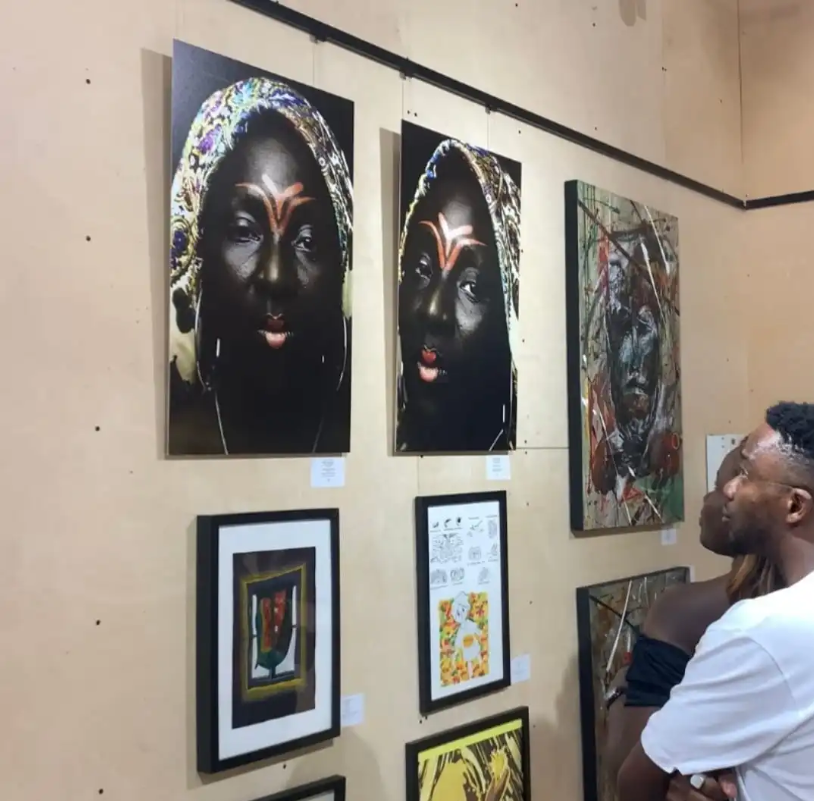Art Review: Abayomi Shogbade’s “Shades of Sovereignty”
Written by Ade Olusola Kunmi
Abayomi Shogbade, a Nigerian-born visual artist and fine art photographer, recently unveiled two compelling works at the Holy Art Gallery’s Alchemy Exhibition in London. The exhibition provided an ideal platform for Shogbade’s “Shades of Sovereignty,” a pair of art photographs that delve deep into themes of life, longevity, and cultural identity.
“Shades of Sovereignty” features two striking photographs of an aged Black woman, whose presence is both commanding and introspective. Set against a black background, the images immediately draw the viewer’s attention to the intricate details of the subject’s facial painting, a practice deeply rooted in African art and spirituality. The almost red facial markings stand out vividly, highlighting the model’s head and lips. Complementing this is a beautifully patterned head scarf, a symbol of the rich cultural heritage and the everyday practices of African women.
The monochromatic backdrop serves to emphasize the facial paintings and the model’s expressions, creating a stark yet powerful contrast that underscores the depth and complexity of the themes explored. The use of minimalistic color palette enhances the spiritual and cultural significance of the facial paintings, suggesting a deep connection to traditional African rituals and the wisdom they embody.
At the heart of “Shades of Sovereignty” is an exploration of life and longevity. Shogbade’s work invites viewers to reflect on the essence of existence, the impact of one’s life choices, and the legacy left behind. The aged model, with her serene yet penetrating gaze, seems to possess an inner wisdom that beckons viewers to ponder the profound questions of life. Her eyes, rich with unspoken stories, convey a sense of hidden knowledge and experience, drawing the audience into a contemplative state.
The facial paintings, a common art and spiritual practice among Africans, serve as a visual narrative that connects the past with the present. They symbolize not only the personal history and identity of the model but also the collective memory and cultural heritage of African communities. The head scarf, with its intricate patterns, further anchors the model’s identity in a specific cultural context, celebrating the beauty and resilience of African womanhood.
Shogbade’s photographic technique is both meticulous and evocative. His focus on facial expressions and the symbolic use of body art create a powerful visual language that communicates complex themes without the need for words. The black background isolates the subject, allowing viewers to engage fully with the emotional and cultural depth of the images.
In “Shades of Sovereignty,” Shogbade’s mastery of light and shadow enhances the textures and contours of the model’s face, bringing out the nuances of her expressions and the intricate details of the facial paintings. The subtle play of light adds a three-dimensional quality to the photographs, making the subject appear almost lifelike and intensely present.
In previous exhibitions, such as the Madeke Modern Art Exhibition, Shogbade’s portraits have consistently focused on the facial expressions and decorations of his models. His “Regal Bloom” series, for instance, celebrated the transition of young girls into womanhood, capturing the beauty and strength of the female gender through intricate body art and emotive expressions.
“Shades of Sovereignty” continues this exploration but with a deeper, more introspective approach. The emphasis on an older model shifts the narrative towards themes of wisdom, legacy, and the passage of time, broadening the scope of Shogbade’s artistic inquiry.
Abayomi Shogbade is a brilliant artist who uses photography to tell profound stories about life, identity, and culture. His works are not just visual representations but are imbued with rich layers of meaning that engage the viewer on multiple levels. “Shades of Sovereignty” is a testament to his ability to capture the essence of his subjects and to evoke deep emotional and intellectual responses from his audience.





